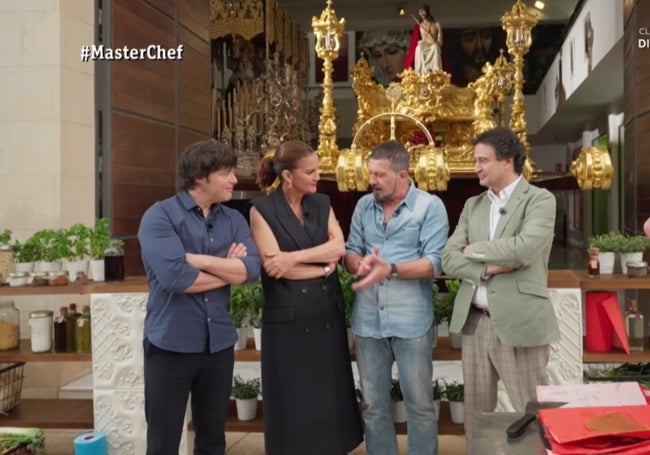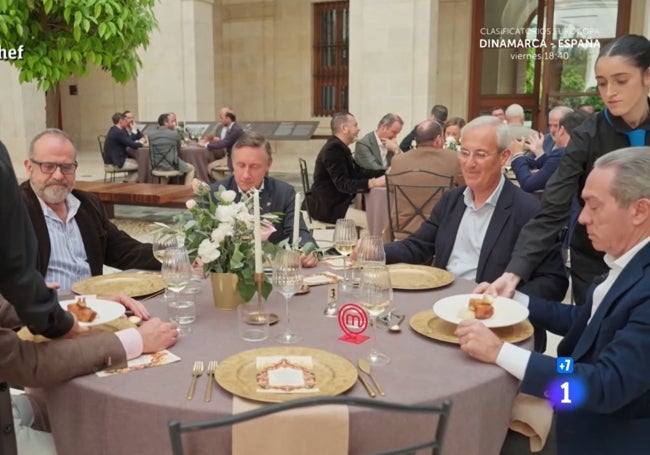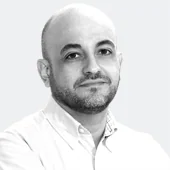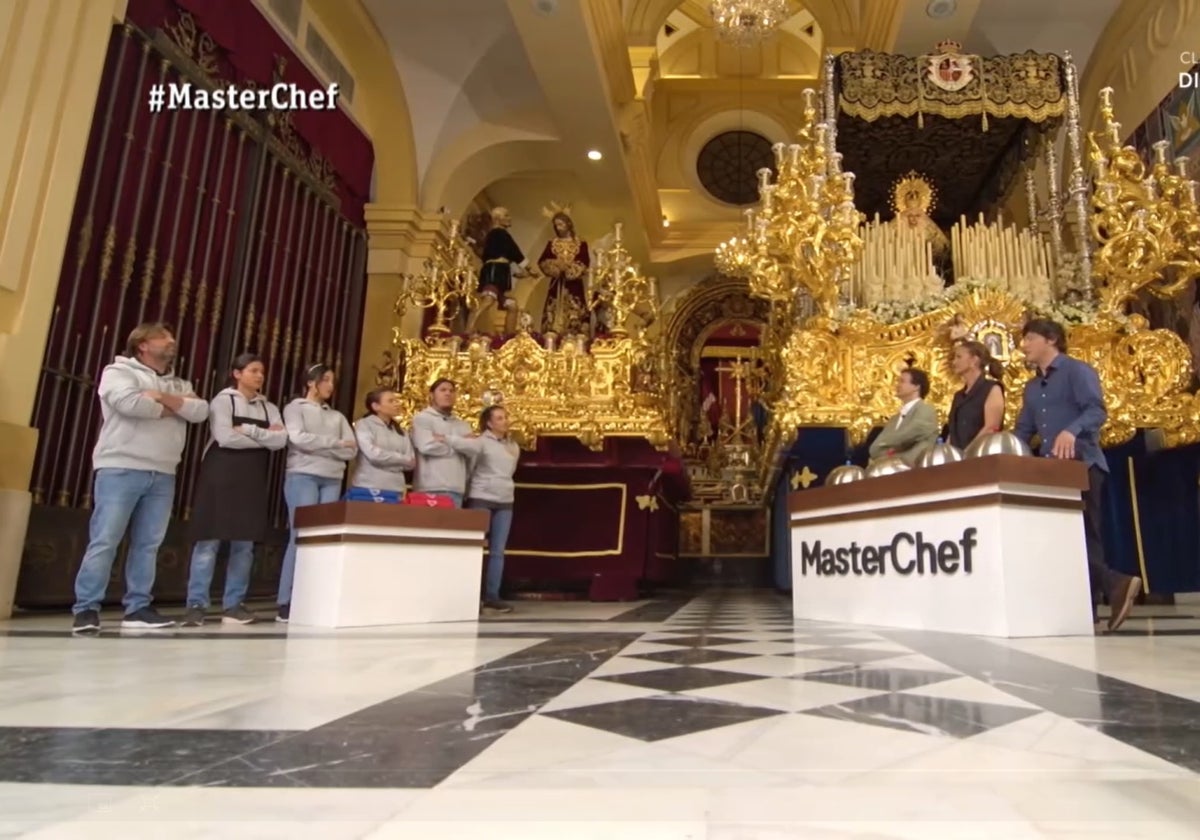Spanish MasterChef airs episode featuring controversial Malaga Holy Week backdrop
TVE broadcasts the talent show that was filmed in Malaga just before Easter and which led the diocese to ask the brotherhoods for explanations
Two months after it ended, Malaga's Holy Week is once again in the spotlight thanks to the Spanish TV cooking talent show MasterChef. This Wednesday, it broadcast its programme recorded in the days leading up to Palm Sunday in two of Malaga's brotherhoods, among other locations, such as the Plaza del Obispo and the Palacio de la Aduana. The programme raised controversy because it was filmed against a backdrop of Holy Week images that were on display ahead of the processions of the brotherhoods of Los Estudiantes and La Paloma, considered a mark of disrespect.
During the episode broadcast this week, the images of the Cristo Coronado de Espinas (Christ Crowned with Thorns) and the Virgen de Gracia y Esperanza (the Virgin of Grace and Hope), from the brotherhoods of los Estudiantes, and those of Jesús de la Puente del Cedrón and the Virgen de la Paloma (Virgin of the Dove) were visible during the programme, serving as a backdrop of the show presented by Pepe Rodríguez, Samantha Vallejo-Nágera and Jordi Cruz. The recording of this cookery competition in front of the sacred figures of both brotherhoods, and the controversy that arose afterwards, led the Diocese of Malaga to ask for explanations from the heads of both organisations.
The part dedicated to Malaga's Holy Week was the team test, which began inside the premises of La Paloma, where two teams of three contestants each were formed and were shown the dishes they had to cook, based on the gastronomy of Lent and Holy Week. Previously, and throughout this part of the programme, images of the processions were shown and the richness of the Malaga brotherhood tradition was highlighted by the presenters. In one of the texts read by Jordi Cruz it was described as "a sublime experience".
Lunch for the brothers and sisters
At the end of this part of the programme based at La Paloma, Samantha Vallejo-Nágera announced that the dishes would be served to 60 diners, who were the older brothers and directors of the brotherhood association, Agrupación de Cofradías, as well as various political leaders, seated at tables in the courtyard of the palace of the Aduana, now the Malaga Museum. He also pointed out that the surplus of the products used was to be donated to the Santo Domingo soup kitchen.
Afterwards, it was time for the contestants to cook the dishes for 180 minutes, in Calle Alcazabilla, but with the backdrop of the Los Estudiantes brotherhood house with its doors open, meaning the images of the Christ and the Virgin could be seen at all times.
In this phase of the competition, the presenters disputed the choice of teams with a short test on how quickly they could light the candles, at which point Pepe Rodríguez and Samantha Vallejo-Nágera used the term "costaleros", possibly unaware that this term is not used to describe the bearers of the thrones in Malaga, whereas it is used in Seville, among other places.
The actor Antonio Banderas played a leading role in the preparation of the dishes, appearing to encourage the contestants and announcing the bad news that they had to change teams in the middle of the menu, to make the challenge more difficult. Banderas explained that he is a brother of the Cofradía de los Estudiantes, but that he goes out every year with Fusionadas (a different brotherhood). He also spoke of his upcoming professional projects.

Afterwards, the tasting of the dishes began in a lunch served in the courtyard of the Museum of Malaga. Samantha Vallejo-Nágera briefly interviewed the president of the Agrupación de Cofradías, José Carlos Garín, who spoke about the social work carried out by the Corinto Foundation; the elder brother of the Paloma, Diego Hermoso; the mayor, Francisco de la Torre; the elder brother of the Estudiantes, Jorge Alcántara; and the elder brother of the Santo Traslado, Jesús Díaz. The questions were about different aspects of the brotherhood and about the dishes they were tasting. Jesús Díaz, who was named as an "elder brother of the Hermandad de la Escuela de San Pablo", instead of the Soledad de San Pablo, criticised the torrija he had been served for being "a little overcooked and dry".
Finally, in the Plaza del Obispo, with the central gate of the cathedral's atrium open, the presenters revealed the winning team of the outdoor test, and images of the surroundings of the cathedral taken with a drone were shown again.

Initially, the production company of MasterChef had contacted the brotherhood of Esperanza and the congregation of Mena to carry out the recordings. However, they ruled out Mena because the figures were not going to be on display for the filming day, and in the end, Esperanza refused to host the programme, despite the fact that the production company's planning for that location was already well advanced. So they looked for alternative locations on the condition that they had ample space for the camera shot, hence the choice of the headquarters of the brotherhoods of Estudiantes and La Paloma.
The controversy over the recording of this MasterChef programme was followed, the week after Holy Week, by a video shared on social media made by workers of Zara in Calle Liborio García in which they promoted their brand of clothing using models in environments such as the interior and gardens of the cathedral, and the church of San Pedro, during the kissing of the Virgen de los Dolores of the brotherhood of the Expiration. Both the diocese and the brotherhood issued statements in which they disassociated themselves with these recordings.

